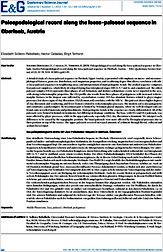| dc.contributor.author | Solleiro-Rebolledo, Elizabeth | |
| dc.contributor.author | Cabadas, Hector | |
| dc.contributor.author | Terhorst, Birgit | |
| dc.date.accessioned | 2013-06-16T17:04:57Z | |
| dc.date.available | 2013-06-16T17:04:57Z | |
| dc.date.issued | 2013-06-16 | |
| dc.identifier.citation | E&G – Quaternary Science Journal; Vol.62, No.1, p.22-33 | |
| dc.identifier.uri | http://hdl.handle.net/11858/00-1735-0000-001E-A3E6-0 | |
| dc.description.abstract | A detailed study of a loess-paleosol sequence in Oberlaab, Upper Austria, is presented with emphasis on macro- and micromorphological features, grain size distribution, rock magnetism properties, and weathering degree that allows correlation with other loess-paleosol sequences in neighboring areas, and interpretation of main pedogenic trends. The studied sequence comprises four paleosol complexes, which likely developed during four interglacial stages MIS 11, 9, 7 and 5e, and a modern soil. The oldest paleosol complex (OL5) represents three phases of soil formation, and distinct sedimentary events never reported in the area, with strong reductomorphic properties. The OL4 profile also results from three phases of pedogenesis with increased reductomorphic features in the deepest zone (affected by cryoturbation events). OL3 has abundant features related to gleyic/stagnic processes, but shows signs of clay illuviation. OL2 (Eemian soil) correlates with the MIS 5e. This paleosol shows higher degrees of clay illuviation and weathering, and fewer features related to reductomorphic processes. The modern soil is also polygenetic and constitutes a pedocomplex. Its lowermost part is formed by Würmian glacial deposits, where no well-developed soils are found; only reworked materials and pedosediments. Main pedogenic trends in the sequence are clearly differentiated. All of the paleosols were formed in humid environments, but differing in drainage conditions. The base, with OL5 and OL4 paleosols, was more affected by gleyic processes, while in the upper paleosols, especially OL2, clay illuviation is dominant. We interpret such differences to be caused by the topographic position. The basal paleosols were more affected by fluvioglacial processes due to their position on top of the terrace. The upper paleosols received increased amounts of sediment through fluvial, colluvial and aeolian (loess) input. | |
| dc.language.iso | eng | |
| dc.publisher | Geozon Science Media | |
| dc.relation.ispartofseries | E&G | |
| dc.subject.ddc | 551 | |
| dc.title | Paleopedological record along the loess-paleosol sequence in Oberlaab, Austria | |
| dc.type | article | |
| dc.bibliographicCitation.volume | 62 | |
| dc.bibliographicCitation.issue | 1 | |
| dc.bibliographicCitation.firstPage | 22 | |
| dc.bibliographicCitation.lastPage | 33 | |
| dc.identifier.doi | 10.23689/fidgeo-1935 | |
| dc.type.version | Verlagsversion | |
| dc.rights.holder | Geozon Science Media | |
| dc.date.updated | 2013-06-16T17:04:58Z | |
| dc.subject.free | loess | |
| dc.subject.free | paleosol | |
| dc.subject.free | pedogenesis | |
| dc.subject.free | middle pleistocene | |
| dc.subject.free | Oberlaab | |
| dc.relation.volume | E&G – Quaternary Science Journal; Vol.62 | |
| dc.bibliographicCitation.journal | E&G | |
| dc.relation.collection | Geologische Wissenschaften | |
| dc.description.type | research | |


